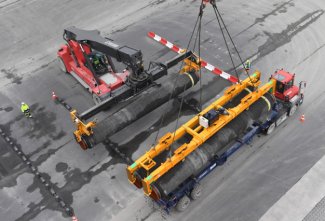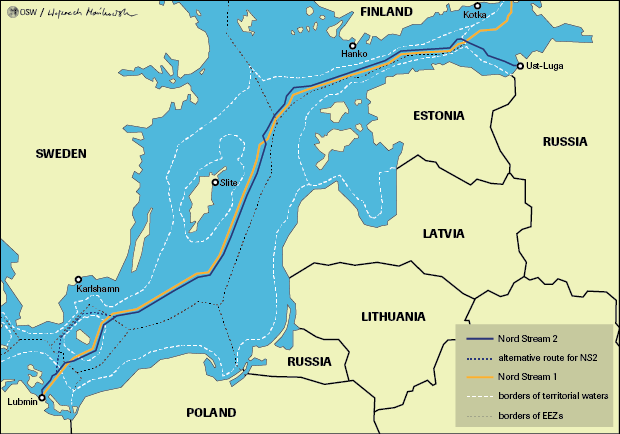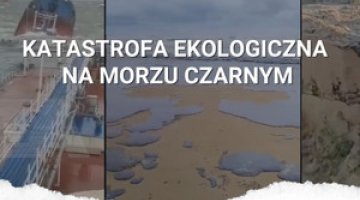Work starts on Nord Stream 2’s construction

On 5 September, the Nord Stream 2 company began laying the first pipes in the Gulf of Finland, thus marking the start of the gas pipeline’s construction. The beginning of work on Nord Stream 2’s offshore section was preceded by advanced preparatory work in German territorial waters. The project’s construction has been started despite lacking the necessary set of environmental permits. Denmark has still not granted permission for construction in its waters, and on 10 August Nord Stream 2 applied for an alternative to the primarily planned route, bypassing Danish territorial waters and passing through the country’s exclusive economic zone north of Bornholm. Originally, the route should have run through Danish waters to the south of the island, in parallel to the Nord Stream 1 route.
Commentary
- The start of construction of the gas pipeline without the full set of licences demonstrates that the investor is in a hurry. The Nord Stream 2 company announced that it planned to complete the investment by the end of 2019, which will make it easier to implement Russia’s goals, which include reducing gas transit via Ukraine after the expiry of the transit contract at the end of next year. The beginning of the construction has also pre-empted any actions by the project’s opponents, something which may actually harm its completion. These opponents include both the US (which has been hinting increasingly often that it could impose sanctions on Nord Stream 2), and the European Commission, which has called for an amendment to the EU’s gas directive to guarantee that the project will be subject to EU law. The start of construction also puts pressure on Denmark, as it is a signal that the pipeline will be built, regardless of Copenhagen’s final decisions.
- Thanks to an amendment to the country’s law in 2017, Denmark, where the majority of parties in parliament oppose NS2, can block the construction of the gas pipeline in its territorial waters to the south of Bornholm (which was the original route as laid out in the first plan from April 2017), out of consideration of the security and/or foreign policy interests of the country. However, the Danish government does not want to take sole responsibility for taking the decision concerning such a difficult issue, one which has divided Copenhagen’s most important allies (in particular the US and Germany). Up until now it has been playing for time, hoping that a consensus would be achieved at EU level. At the same time, Denmark (like any other state) cannot block investment for other than environmental reasons, in the event of a pipeline running through its exclusive economic zone, as the alternative route provides for. From the perspective of Denmark’s interests, the path of NS2’s alternative route is also perplexing; an intensively used shipping route runs north of Bornholm, whose functioning would be affected by the laying of a gas pipeline.
- Despite the start of work on NS2, Denmark’s consent is essential not only to complete the whole investment, but also to carry out a large part of the work at the bottom of the Baltic Sea. Consequently, the pace of the pipeline’s construction will be dependent on what decision Copenhagen takes and how soon it will make that decision. In connection with the Danish delay in making the decision, and with the investor’s submission of a new proposal, the completion of the project is likely to be delayed. We should therefore expect further pressure to be put on Denmark by the companies involved in the project and the countries supporting it, as well as the opponents of NS2.
- Despite the major controversy in Europe and in the US surrounding it, the start of NS2’s construction will probably deepen the divisions and exacerbate the protests by opponents of the project, especially in Washington. This is almost certainly why the construction of the pipeline started in Finland, and not in Germany, whose relations with the US have deteriorated. The reaction of the United States at the start of NS2’s construction will be the next important factor, alongside Denmark’s actions, in determining the pace and final shape of the project.
- American sanctions against NS2 are probably the only factor that could block the pipeline’s construction, or at least substantially hinder the investment’s completion. At the end of August, the Uniper group stated its concerns related to sanctions. If these should come into force, most European companies would most probably withdraw their financial support for the pipeline. Another challenge for NS2 could be the implementation of amendments to the EU’s gas directive proposed by the European Commission; depending on the final shape of the legislation, these could apply to Nord Stream 2 even after construction of the pipeline has started. However, it seems unrealistic that there will be any amendment to the directive in the coming months; Austria, which now holds the Presidency of the Council of the EU (and is at the same time one of the EU states more supportive of Nord Stream 2), has no plans to accelerate work on it before the end of 2018.
Agata Łoskot-Strachota, additional research by Piotr Szymański
Map. The planned route of the Nord Stream 2 pipeline





